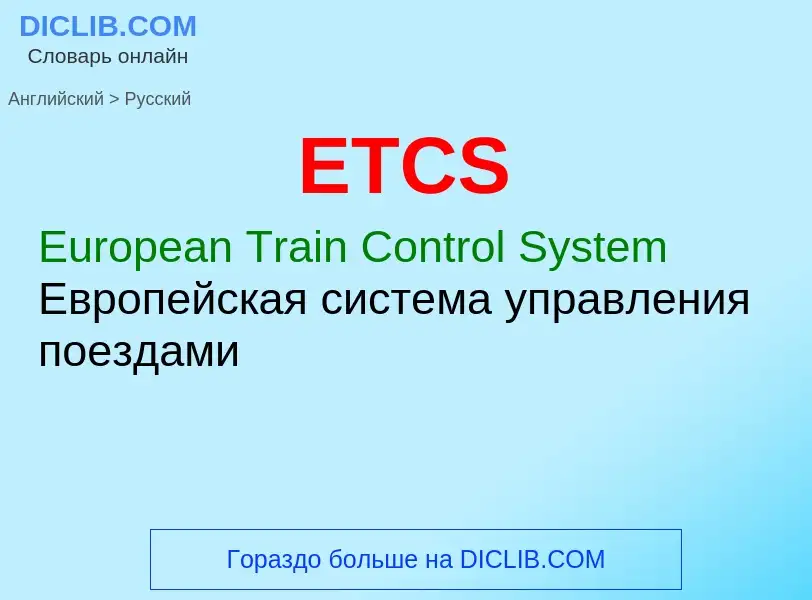ترجمة وتحليل الكلمات عن طريق الذكاء الاصطناعي ChatGPT
في هذه الصفحة يمكنك الحصول على تحليل مفصل لكلمة أو عبارة باستخدام أفضل تقنيات الذكاء الاصطناعي المتوفرة اليوم:
- كيف يتم استخدام الكلمة في اللغة
- تردد الكلمة
- ما إذا كانت الكلمة تستخدم في كثير من الأحيان في اللغة المنطوقة أو المكتوبة
- خيارات الترجمة إلى الروسية أو الإسبانية، على التوالي
- أمثلة على استخدام الكلمة (عدة عبارات مع الترجمة)
- أصل الكلمة
ETCS - ترجمة إلى الروسية
общая лексика
Enhanced Transmission Correction
усовершенствованный протокол передачи [данных] с коррекцией [ошибок]
протокол, используемый в сотовой связи
сокращение
[estimated yearly consumption] расчётное годовое потребление
ويكيبيديا

The European Train Control System (ETCS) is the signalling and control component of the European Rail Traffic Management System (ERTMS). It is a replacement for legacy train protection systems and designed to replace the many incompatible safety systems currently used by European railways. The standard was also adopted outside Europe and is an option for worldwide application. In technical terms it is a type of positive train control (PTC).
ETCS is implemented with standard trackside equipment and unified controlling equipment within the train cab. In its advanced form, all lineside information is passed to the driver wirelessly inside the cab, removing the need for lineside signals watched by the driver. This will give the foundation for a later to be defined automatic train operation. Trackside equipment aims to exchange information with the vehicle for safely supervising train circulation. The information exchanged between track and trains can be either continuous or intermittent according to the ERTMS/ETCS level of application and to the nature of the information itself.
The need for a system like ETCS stems from more and longer running trains resulting from economic integration of the European Union (EU) and the liberalisation of national railway markets. At the beginning of the 1990s there were some national high speed train projects supported by the EU which lacked interoperability of trains. This catalysed the Directive 1996/48 about the interoperability of high-speed trains, followed by Directive 2001/16 extending the concept of interoperability to the conventional rail system. ETCS specifications have become part of, or are referred to, the Technical Specifications for Interoperability (TSI) for (railway) control-command systems, pieces of European legislation managed by the European Union Agency for Railways (ERA). It is a legal requirement that all new, upgraded or renewed tracks and rolling stock in the European railway system should adopt ETCS, possibly keeping legacy systems for backward compatibility. Many networks outside the EU have also adopted ETCS, generally for high-speed rail projects. The main goal of achieving interoperability had mixed success in the beginning.
Deployment has been slow, as there is no business case for replacing existing train protection systems, especially in Germany and France which already had advanced train protection systems installed in most mainlines. Even though these legacy systems were developed in the 1960s, they provided similar performance to ETCS Level 2, thus the reluctance of infrastructure managers to replace these systems with ETCS. There are also significant problems regarding compatibility of the latest software releases or baselines of infrastructure-side equipment with older on-board equipment, forcing in many cases the train operating companies to replace ETCS equipment after only a few years. Switzerland, an early adopter of ETCS Limited Supervision, has introduced a moratorium on its planned roll-out of ETCS Level 2 due to cost and capacity concerns, added to fears about GSM-R obsolescence starting in 2030.






![A [[Doppler radar]] odometry system mounted on the underside of a railway vehicle A [[Doppler radar]] odometry system mounted on the underside of a railway vehicle](https://commons.wikimedia.org/wiki/Special:FilePath/Etcs471042 08 doppleruvradar.jpg?width=200)



![English claims on France]] English claims on France]]](https://commons.wikimedia.org/wiki/Special:FilePath/Cromwellcoin.jpg?width=200)
